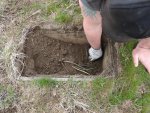Installer
Senior Member
- Location
- DesMoines, Washington
Any Solutions to running PVC conduit in a Curved path?
I'm running 2" conduit up here the PNW (Pacific Northwest). I need to veer away from my Electrical Source because there are communication lines in the area and then turn and come back and head to my Destination.
If I did it, I would just use 90 degree or 45 degree elbows and get there eventually and hope the backhoe doesn't mind the funny path.
Out of curiosity is that the way its done professionally?
Thank you in advance.
I'm running 2" conduit up here the PNW (Pacific Northwest). I need to veer away from my Electrical Source because there are communication lines in the area and then turn and come back and head to my Destination.
If I did it, I would just use 90 degree or 45 degree elbows and get there eventually and hope the backhoe doesn't mind the funny path.
Out of curiosity is that the way its done professionally?
Thank you in advance.




